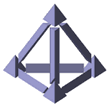
 |
Web services encompass technologies for deploying and providing access to functionality over the web. Each web service is a self-contained, self-describing modular component that communicates using XML messages.
SOAP
The Simple Object Access Protocol (SOAP) is a lightweight protocol for exchange of information between diverse and distributed computing environments. It combines the extensibility and portability of XML with the ubiquitous web technology of HTTP. It provides a framework for defining how an XML message is structured using rich semantics for indicating encoding style, array structure, and data types. SOAP 1.1 was submitted as a W3C Note in May 2000 and SOAP 1.2 is now a W3C Working Draft.
SOAP 1.2 consists of:
- An envelope that defines a framework for describing what is in a message and how to process it.
- A transport binding framework for exchanging messages using an underlying protocol.
- A set of encoding rules for expressing instances of application-defined data types.
- A convention for representing remote procedure calls and responses.
Main sites and specifications
SOAP 1.1 - A W3C Note
http://www.w3.org/TR/SOAP/
The SOAP 1.2 W3C Working Draft consists of 2 parts:
SOAP Version 1.2 Part 1: Messaging Framework - describes the SOAP envelope
and the SOAP transport binding framework
http://www.w3.org/TR/soap12-part1/
SOAP Version 1.2 Part 2: Adjuncts - describes the SOAP encoding rules
the SOAP RPC convention and a concrete HTTP binding specification
http://www.w3.org/TR/soap12-part2/
Overviews and tutorials
| Simply SOAP | High level discussion of SOAP, in terms of both what it is and how you can use it. |
| W3Schools SOAP School | What SOAP is, how it can be used, syntax rules, examples and error handling. |
| SOAP FAQ | Frequently asked questions |
WSDL
The Web Service Description Language (WSDL) can be used to describe a web service, providing a standard interface. A WSDL document is written in XML and describes a service as a set of endpoints, each consisting of a collection of operations. XML input and output messages are defined for each operation and their structure and data types are described using an XML Schema in the WSDL document. The WDSL and XML Schema provide a complete definition for the service interface, allowing programmatic access to the web service, in the manner of an API. Tasks like data requests or code execution can be performed by sending or receiving XML messages using, for example, SOAP.
Main sites and specifications
Web Services Description Language (WSDL) 1.1 - W3C Note
http://www.w3.org/TR/wsdl
Overviews and tutorials
| A Quick Introduction to WSDL | From Microsoft's SOAP Toolkit 2.0. |
| The XML Cover Pages: WSDL | Good collection of resources about WSDL, with the most recent developments listed first. |
| Introduction to WSDL | Devexpert introduction to WDSL, aimed at VB programmers. |
UDDI
The Universal Description, Discovery and Integration (UDDI) specification defines a way to publish and discover information about web services. It is a collaboration between Ariba, IBM and Microsoft to speed interoperability and adoption of web services. The project includes a business registry (an XML document) and a set of operations on it. The registry can be used by programs to find and get information about web services and check compatibility with them, based on their descriptions. UDDI allows categorisation of web services so that they can be located and discovered and WSDL enables a programmatic interface to a service once it has been located.
Main sites and specifications
Overviews and tutorials
| UDDI Executive White Paper (pdf) | Executive summary of UDDI. |
| UDDI Technical White Paper (pdf) | Conceptual overview of UDDI for the purpose of understanding what it is, who uses it, and how a distributed registry makes it possible to discover and interact with web services. |
| DISCO and UDDI publishing & discovery (pdf) | Publishing/Discovering Web Services via DISCO/UDDI. Slide show type presentation on Microsoft's DISCO (Discovery of Web Services) and UDDI as a better alternative to DISCO. |
| Using WSDL with UDDI (pdf) | Using WSDL in a UDDI Registry 1.07 - UDDI Working Draft best practices document. |
Microsoft .NET Framework
The Microsoft .NET ("dotnet") Framework is a new platform, based on open Internet protocols and standards, for building integrated, service-oriented software applications. It features ease of development of web-based services, rich standard run-time services available to components written in a variety of programming languages, and inter-language and inter-machine interoperability.
Main sites and specifications
MSDN's .NET Home Page - Where Microsoft puts all of its most important
.NET information, articles, samples, and links.
http://msdn.microsoft.com/NET/default.asp
Microsoft's GotDotNet Page - A community Web site, written by and maintained
by the Microsoft .NET Framework Web Team.
http://www.gotdotnet.com/
Overviews and tutorials
| What is .NET? | Microsoft overview of .NET |
| W3Schools .NET School | Describes what .NET is and what it holds for the future. Also describes the core building blocks, development tools, standards and links to other resources and books. |
| .NET as the Platform for an Integrated, Service-Oriented Web | MSDN article illustrating how the .NET Framework enables you to quickly build and deploy Web services and applications in any programming language. Assumes you’re familiar with Web Programming |
| Web Services as Building Blocks for .NET | MSDN article about the Programmable Web. This is a more in depth article describing Web Services and the components of the Microsoft .NET Framework, including the common language runtime, the services framework, and the programming models for building and integrating Web Services. Assumes you’re familiar with HTTP and XML |
School of Engineering Sciences, University of Southampton, Highfield, Southampton SO17 1BJ
Tel: +44 (0)2380 593116, Fax: +44 (0)2380 597082 Email: projectoffice@geodise.org
© The Geodise Project 2001-2004
